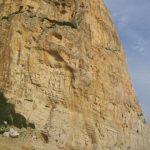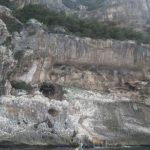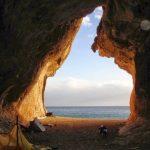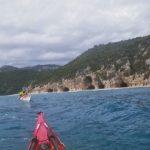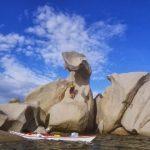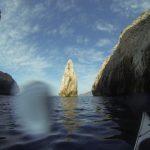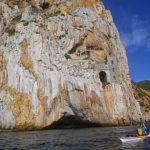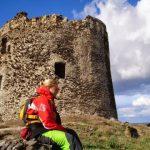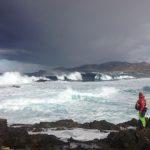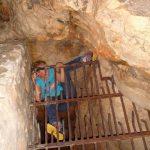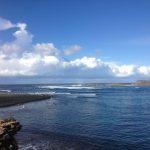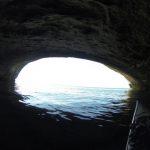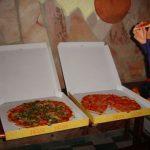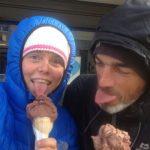Sardinia is the second largest Island in the Mediterranean and is part of Italy. The weather is known to be warm and settled with the best times to paddle being April/May and September/October when the weather is not too hot or stormy. The locals are friendly people and with plenty of maritime towns on the coast you can absorb the Sardinian culture, although traditionally Sardinians lived inland due to the past military invasions by sea. The water is warm, crystal clear with a beautiful turquoise colour just asking to be explored with a snorkel. The coastline has towering cliffs and white sandy beaches, with an ever changing array of geology the coastline is continuously changing.
I tried to circumnavigate the island in October/November 2013 and was narrowly defeated. Here’s a list of the five best spots to paddle on the island, so that many other people can appreciate Sardinia’s finest kayaking.
1
Capo di Monte Santu
My favourite spot on the island is on the east coast, not far north of the town of Tortoli. It has the highest towering sea cliffs I have ever paddled beneath. This is a committing stretch of coast with very few beaches to land on until passing around Capo di Monte Santu. We started from a large port near Tortoli, however there is a put in at Punta Pedra Longa, as long as you don’t mind a few steps.
Punta Pedra Longa is the first big cliff you come to with a huge free standing tower climbing out of the sea, there is even a cafe at the top if you’re paddling during tourist season. Camps are difficult to find on this stretch of coast and we settled for crazy concrete foundations in the bushes just up from a narrow rocky beach.
Heading around the Capo di Monte Santu was amazing the cliffs felt like they rose from the sea and never stoped heading towards to sky; this area of coast is well known to climbers, however the access to these cliffs is very difficult by land.
Once around the Capo there are a small selection of coves to explore some with the most stunning white pebbles and not a soul in sight. The rock towers appear around every corner balancing beautifully in the mountainous landscape. There is a cave system called Grotta del Bue Marino, which looked intriguing while we were paddlling past, unfortunately it was inaccessible, locked up for the off season. It is said to be an amazing cave to explore and attracts many tourists in the summer, day trippers will normally all arrive by boat from a small town a little further north.
The cliffs gradually start to drop in height and more arches and caves appear due to yet another change in rock type. Cala di Luna is the next magical cove with 6 natural caves to explore and white sandy beaches. A great place to camp in calm conditions but best avoided in an Easterly swell due to huge dumpy waves on the steep sandy beach. Once you have had your fill of these great natural caves it is only a short paddle to the next town of Cala Gonone. With supermarkets and cafes it is a very welcome little town to stop in.
2
Buggerru
With the name Buggerru you can’t help but stifle a small giggle, I was intrigued to see what this little mining town had to offer. Paddling out of this town is a little less committing as there are a few more beaches and less distance between each possible landing. There are two directions which can be explored. Heading out north will provide beautiful granite cliffs and bolder sculptures, with crystal clear water the magic can be seen above and below with many small reefs are clustered just off the shore.
Once around the Capo Pecora the granite headland gives way to long sand beaches and soon to massive sand dunes, which are begging to be explored. Be aware that when paddling past Punta su Covia you are entering a military area and expect to be inspected by fly-bys and military ribs (best avoided especially if Italian isn’t one of your best languages).
South from Buggeru is also a paddling delight, with caves that go so deep they never seem to end and huge limestone cliffs with character that is yet again very different. Enjoy at sea arches and turquoise waters as they cant fail to impress. The interest just keeps coming and as you paddle around the coast a huge stack appears which is well worth exploring with various routes cutting straight through the stack. Keep heading south as the next delightful sight is Porto Flavia, an old port built into the towering cliffs to get the mined ore onto the ships. With many other mine works to explore just head 500 metres past Porto Flavia to find small pebble coves to land in, you may even find the dark tunnel that connects the coves to one another.
3
Stintino & Capo Caccia
the northwest corner
Many days can be spent paddling around this impressive area. The 80 km stretch of coast between Stintino and Alghero is a must see. At the headland of Capo Falcone is where the calm bays of Stintino meet the wild and rugged coast. Yet more towering cliffs and islands to explore – this area is a popular destination for visitors. The choice of paddling the whole coastal section between the two towns will provide the best experience, however a day trip around Islola Asinara is also an enjoyable but long day.
Capo Caccia is a spectacular paddle which shouldn’t be missed on a visit to the island. There is a large sheltered bay with many places to launch right next to a huge headland which cant fail to impress. A fantastic Grotto can be accessed by land via a never-ending path of steps or in calm conditions a cheeky sea kayaker can enter from the sea. Having snuck in here one evening I can recommend a torch and a tour guide.
These cliffs are again hundreds of metres tall and incredibly steep. The sea stacks just off shore provide some exciting sea arches in swell conditions however there isn’t really any options to land until right around the point much further north.
4
Isola Tavolara
Imagine a long mountain growing out of the ocean toped with a steep long ridge and this is Islola Tavolara. Yet another nature reserve this area has a dramatic coastline to explore. With restaurants at the West end of the Island lunch can be easy to find if you don’t mind sharing with the tourists, although abandoned out of season apart from the military presence. The Eastern end of the Island is a little more remote with a light house sited on the seaward tip. The coast is popular with small boats and yachts so the water can be a little busier due to the city of Olbia only being a stones throw away.

A crossing across to the Capo Figari could be a worthwhile adventure if you want more distance as the Capo has yet more towering cliffs and lighthouses to enjoy. The further North you head from here the more touristy and boat orientated it becomes although huge amounts of military ruins still show the troubled history of Sardinia. Be aware that the Gold de Olbia can be a busy shipping lane.
5
Capo San Marco
A spit of land that pokes out from the mainland, this area is rich with towers and light houses. more white sandy beaches can be enjoyed almost anywhere in this area. We spotted some dolphins or porpoise off this point and it is a protected marine area. Beware this area is a mosquito heaven come dusk and dawn so I recommend being prepared or staying in accommodation.
There is a lovely section of coast just north of this nature reserve where the small town of Santa Caterina di Pittinuri can be found, very pretty from the sea there is some interesting rock formations and arches to explore, even the most bizarre caves where the entrance is huge yet very very low and opens out into a dome shaped room. Gelato and pizza were a great treat as many smaller fishing towns are found in this area.
You will get to see many of the local men enjoying there hobby of spear fishing, so dont be alarmed when you see dozens of floats and flags following around snorkelers with giant weapons and camouflage wetsuits.
Sardinia is definitely a kayak friendly island which offers so much to explore whilst still enjoying the warm climate. It is just a short flight from the UK and kayak hire is easy, wild camping is a no-go in high season but there are many campsites usually with their own beach. I would return to the island anytime for a kayaking holiday, I am even hoping to run a guided trip there next year as I believe that it has some of the most spectacular coastline in the Mediterranean and of course the best pizza and gelato I have ever tasted.
